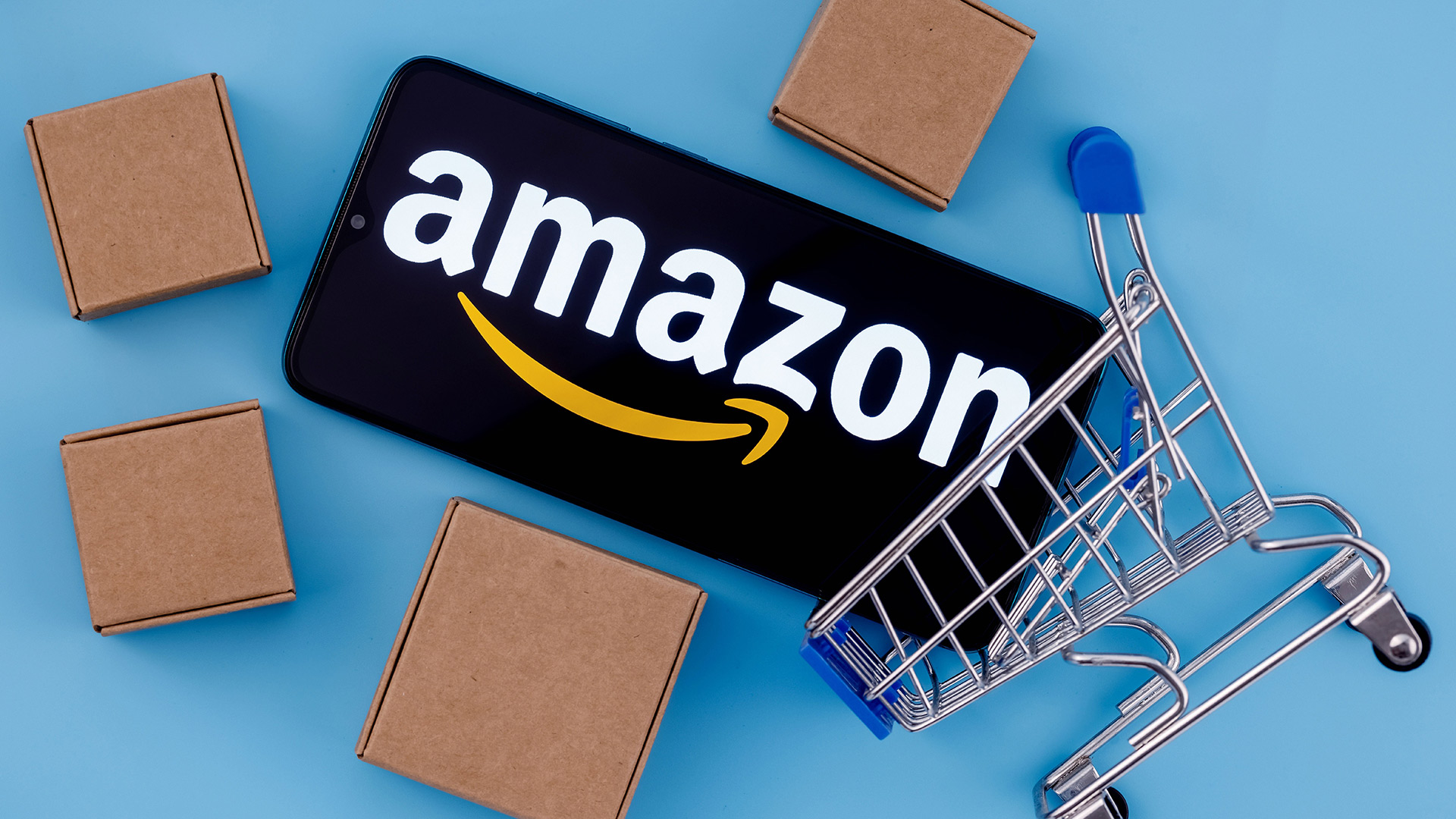Huawei P20 Pro vs. Galaxy S9+: What's the Better Android?
The Galaxy S9 is the best Android phone you can get in the U.S. But are you missing out with Huawei's P20 Pro? Find out in our face-off.
With an optional, color-shifting Twilight finish and triple cameras, Huawei's new P20 Pro is one of the more distinctive phones out there — at least in the parts of the world where Huawei plans to sell its new flagship device. However, the P20 Pro actually has more in common with another popular Android handset than you might think.
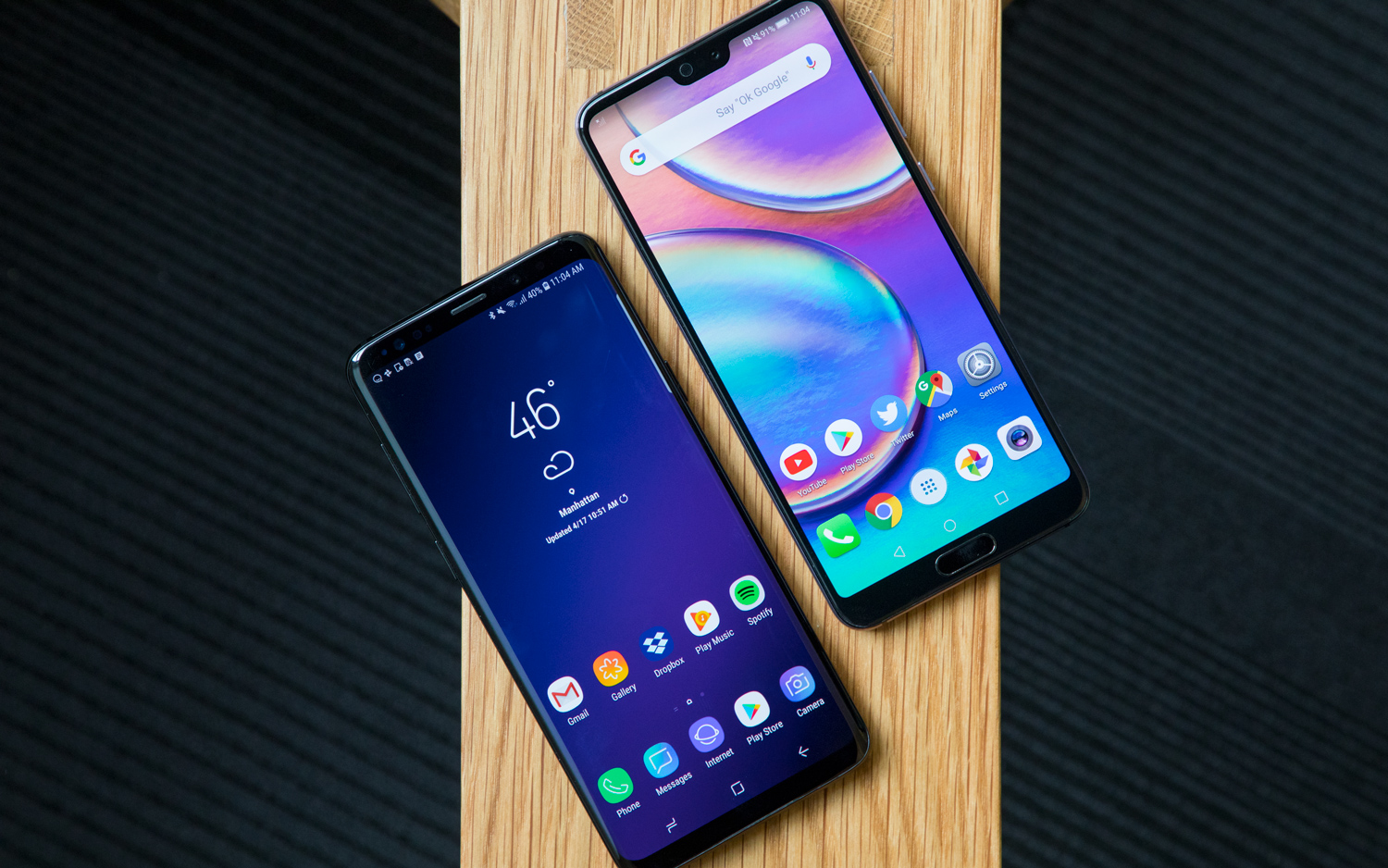
Samsung's Galaxy S9+ can also be had in purple. And while the Galaxy S9+ doesn't carry a trio of lenses on the back, it does have the first mechanically variable aperture ever put into a smartphone.
The P20 Pro may not be on sale in the United States, though that hasn't stopped those interested from placing orders and importing the P20 for themselves. Whether you're floating the idea of doing that yourself or are simply curious about what we're missing on this side of the pond, here's how Huawei's phone compares to the top Android phone that U.S. shoppers can officially buy.
Specs
| Huawei P20 Pro | Samsung Galaxy S9+ | |
| Price | €899 | $840 |
| OS | Android 8.1 Oreo with EMUI 8.1 | Android 8.0 Nougat with Samsung Experience 9.0 |
| Screen Size, Resolution | 6.1 inches (2224 x 1080) OLED | 6.2 inches, 2960 x 1440, AMOLED |
| CPU | Hisilicon Kirin 970 | Qualcomm Snapdragon 845 |
| RAM | 6GB | 6GB |
| Storage | 128GB | 64GB |
| microSD Slot | No | Yes, up to 400GB |
| Rear Camera | Triple: 40 MP (f/1.8); 20 MP (f/1.6) monochrome; 8 MP (f/2.4) telephoto with OIS | Dual: 12 MP (f/1.5 or f/2.4) with OIS; 12 MP (f/2.4) telephoto with OIS |
| Front Camera | 24 MP (f/2.0) | 8 MP (f/1.7) |
| Battery Life (Hrs:Min) | 14:13 | 10:59 |
| Water Resistance | Yes, IP68 | Yes, IP68 |
| Size | 6.10 x 2.91 x 0.31 inches | 6.22 x 2.91 x 0.33 inches |
| Weight | 6.35 ounces | 6.67 ounces |
Design
Set aside your musings about the cookie-cutter nature of today's phone designs for another time. The latest flagships from Samsung and Huawei are equally iconic. You certainly wouldn't confuse one for the other.
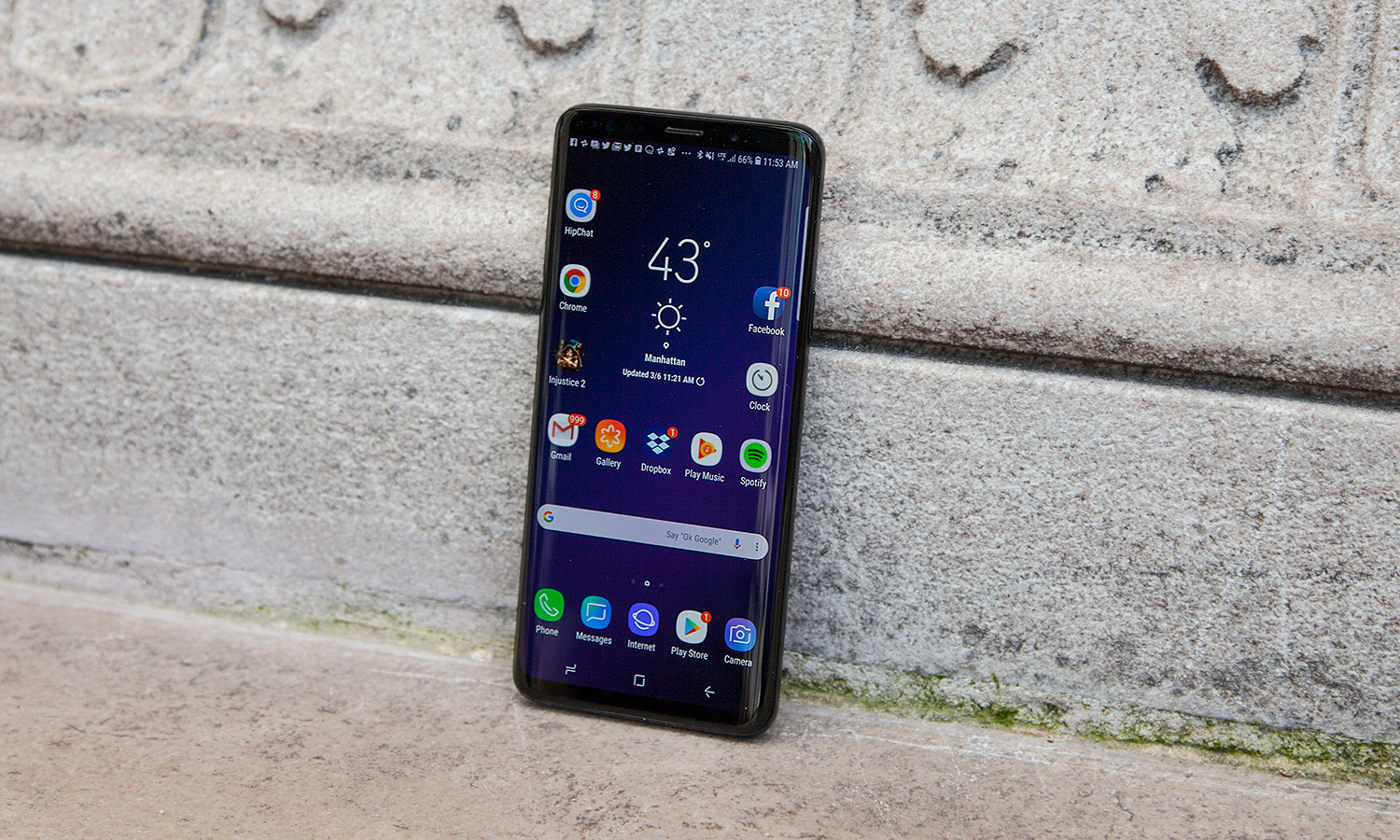
In the Galaxy S9's case, Samsung brings back many of the things we liked about the S8's design. The same wraparound Infinity Display is present, along with those trimmed bezels at the top and bottom. The fingerprint sensor has been shifted from its old position to the right of the S8's camera — it's now underneath, which lessens the chance you'll inadvertently smudge the lens when unlocking your phone. However, it's still quite small and tightly packed, so it's not one of the most ergonomic scanners we've encountered.
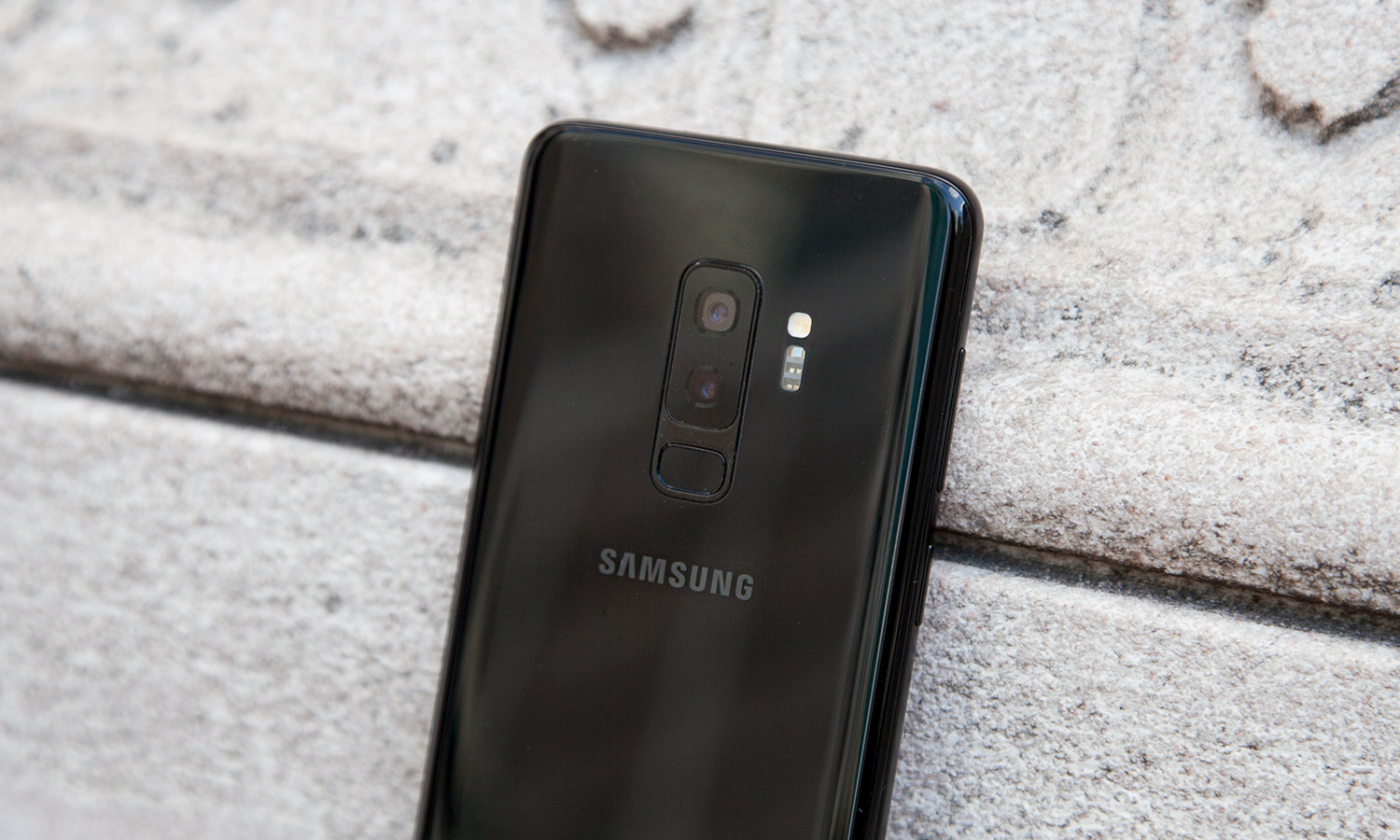
The P20 Pro, on the other hand, looks nothing like any previous Huawei product. As you'd suspect, much of that has to do with the notch on the display. It's considerably smaller than the notch on the iPhone X, but more than twice the size of the Essential Phone's. You can deactivate the P20's notch via software, which makes the left and right sides of the top pitch-black, but either way, notifications still display in that space.
Get instant access to breaking news, the hottest reviews, great deals and helpful tips.

In addition to the notch, Huawei carved just enough room in the bottom bezel for a fingerprint sensor. We find this location more convenient than the behind-the-back strategy Samsung employed, but it leaves the phone's back looking quite sparse. The aforementioned Twilight color is surely a welcome option that is more striking than Samsung's Lilac Purple, but in any other color, the P20 Pro begins to blend in with the crowd.
Ultimately, the Galaxy S9+ wins out here for its still-innovative curved display tech, the lack of a divisive notch and practical considerations like a headphone jack and glass back that supports wireless charging — two features you won't find on the P20 Pro.
Winner: Samsung Galaxy S9+
Display
Samsung supplies the bulk of the smartphone industry with OLED displays (LG is a notable exception), but it saves its best work for its own handsets.
The 6.2-inch S9+ has the finest display we've tested in a smartphone, with impeccable brightness for an OLED panel (603 nits) and an unparalleled range of hues (231 percent of the sRGB color space). The default configuration is quite saturated, but a variety of alternate modes make it easy to customize the screen's output to your liking, whether that's more vivid or more realistic.
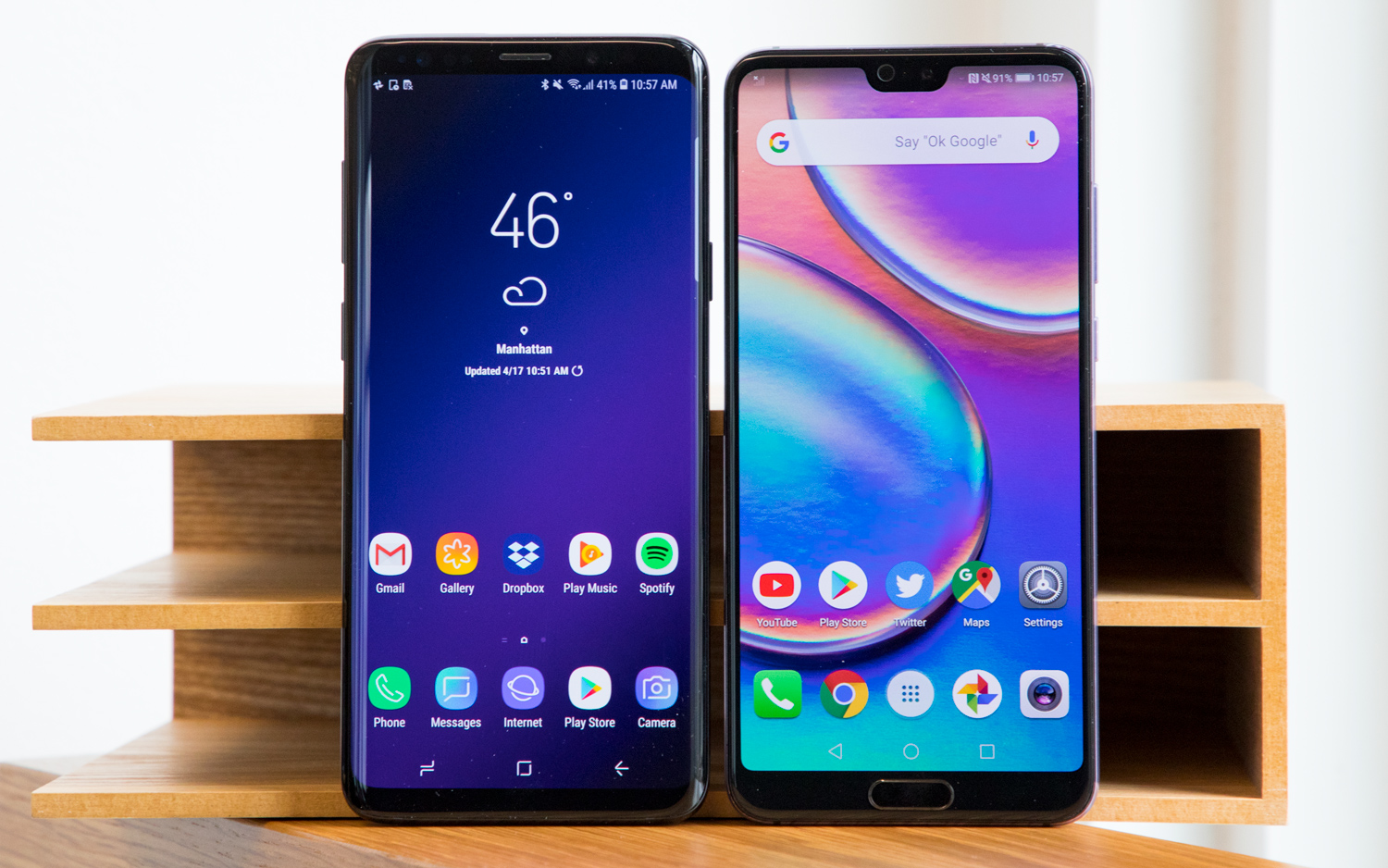
Huawei's hardware also uses a Samsung screen, though it doesn't match the brightness, color intensity or pixel density of the Galaxy S9+. The P20 Pro's 6.1-inch OLED panel topped out at 461 nits and re-created 132 percent of the sRGB spectrum. At 408 pixels per inch, text, apps and media don't quite have the same sharpness as those on the Galaxy S9+, though it's not a massive difference. The P20 Pro has a good display, but it's not the best.
Winner: Samsung Galaxy S9+
Performance
As fast as the Kirin 970 processor inside the P20 Pro is, it's still a generation behind Qualcomm's latest system on chip. The Snapdragon 845 and 6GB of RAM powering the Galaxy S9+ make it the best-performing Android phone we've tested to date, and by a considerable margin.
Every benchmark skewed in Samsung's favor. The Galaxy S9+ turned in a result of 8,295 in Geekbench 4, a test that measures overall system performance. The P20 Pro could only muster 6,240. When it came to graphics, Samsung again bested Huawei's best efforts in 3DMark's Sling Shot Extreme OpenGL ES 3.1 test, with a score of 4,634 compared to 2,991.
MORE: Best Smartphones on the Market Now
To be fair, those numbers do make the performance gulf seem more significant than it is in real-world usage. The mobile version of multiplayer battle royale PlayerUnknown's Battlegrounds was perfectly playable on the P20 Pro, even if the Galaxy S9+ demonstrated a nearly imperceptible frame-rate advantage.
Winner: Samsung Galaxy S9+
Camera
There are a total of four cameras on Huawei's P20 Pro — three on the back and one on the front. The main sensor packs a whopping 40 megapixels, and it's flanked by a 20-MP monochrome lens and an 8-MP telephoto. There's also a 24-MP one for selfies.
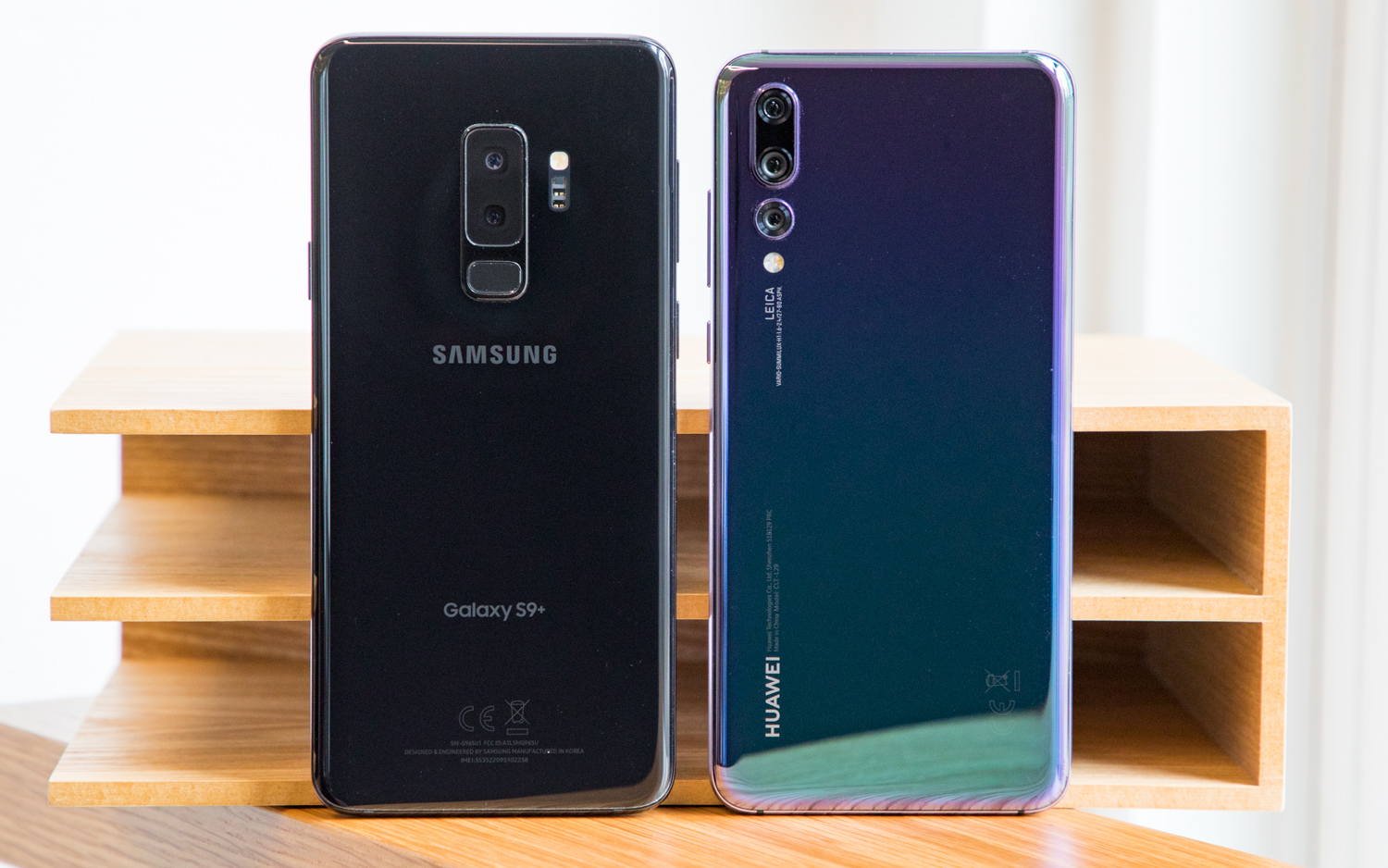
The Galaxy S9+ doesn't have a trio of rear-facing shooters, though Samsung did bring over the Galaxy Note 8's dual cameras while making some serious upgrades along the way. Both shooters are rated at 12 megapixels, though the secondary one is a telephoto lens. The main sensor also sports a variable aperture, with the ability to switch between f/1.5 or f/2.4, depending on the requirements of the scene. Around the front is another 8-MP lens.
So, how do those specs translate when it comes to shooting photos? We put both the P20 Pro and S9+ through a series of side-by-side shots.
Both these photos may look well lit, but they're actually somewhat challenging, because of the intensity of the light coming through the windows. The Galaxy S9+ handles these areas better than the P20 Pro, which overexposes them and opts for a warmer white balance. However, the relative sharpness of the plant leaves from Huawei's device and the slightly punchier colors from the phone's auto-applied Greenery filter produce a more striking result overall — even if we'd like a little more detail in those brighter regions.
Where the P20 Pro really shines is in low-light scenarios. For this shot, I used Huawei's Night Mode, which actually leaves the shutter open for a full 4 seconds while eliminating blur from shaky hands thanks to the phone's exclusive AI Image Stabilization feature.
MORE: Tested: The Huawei P20 Pro's Camera Beats the iPhone X, Pixel 2 XL
The results are remarkable. The P20 Pro's photo is brighter where it needs to be and darker where it doesn't. Although it's not perfect — the night sky has been made to look strangely gray and the corners of the frame are lacking clarity — it's a great deal better than what the Galaxy S9+ produced, which is sharper in certain areas, but overwhelmingly dim. Plus, if you use the P20 Pro's Night Mode in scenes with motion, you get a neat effect, due to the long exposure time — something that's visible in the rendering of the two people crossing the street.
Although the P20 Pro captured a washed-out portrait of my colleague Jorge relative to the Galaxy S9+, I did like how much sharper it was, and the way Huawei's camera toned down the highlights for increased detail.
A similar situation occurs when you're taking selfies. (The S9 has an 8-MP front camera compared to the 24-MP shooter on the P20 Pro.) The colors are surely punchier through Samsung's lens, but there's a noticeable softness to the Galaxy's exposure that really takes something away.
Overall, the P20 Pro is arguably even with the Galaxy S9+ on a sunny day, but it's a superior low-light camera. That means you don't have to worry about it snapping a dingy, underexposed shot when you need it to deliver. For that reason, it's the one we'd rather have during a night out.
Winner: Huawei P20 Pro
Battery Life
Huawei has squeezed a stunning amount of longevity out of the 4,000-mAh battery pack inside the P20 Pro. The handset lasted for 14 hours and 13 minutes in our battery test, where web pages are streamed endlessly over T-Mobile LTE until the battery is depleted. That's far better than the Galaxy S9+, which managed 10 hours and 59 minutes from its 3,500-mAh pack.
MORE: Smartphones with the Longest Battery Life
Eleven hours isn't bad by any means, but for phones as expensive as these two, consumers expect and deserve top-tier battery life. The P20 Pro was also the faster phone to charge as well, hitting 57 percent in 30 minutes with Huawei's stock SuperCharge adapter. The Galaxy S9+ reached just 38 percent in the same amount of time using its included charger.
Winner: Huawei P20 Pro
Software
Both the P20 Pro and Galaxy S9+ run Android Oreo — the latest major release of Google's mobile operating system — out of the box. However, Huawei has a slight advantage, because the P20 Pro features version 8.1, unlike version 8.0 in Samsung's flagships.
The distinction is a small one, but it's reflective of a larger trend. Huawei has done an admirable job of launching its products with the newest iteration of Android, while Samsung has made a habit of starting from behind and failing to stay current. For example, Oreo only began hitting the Galaxy Note 8 in April — seven months after Google made it available to the public.
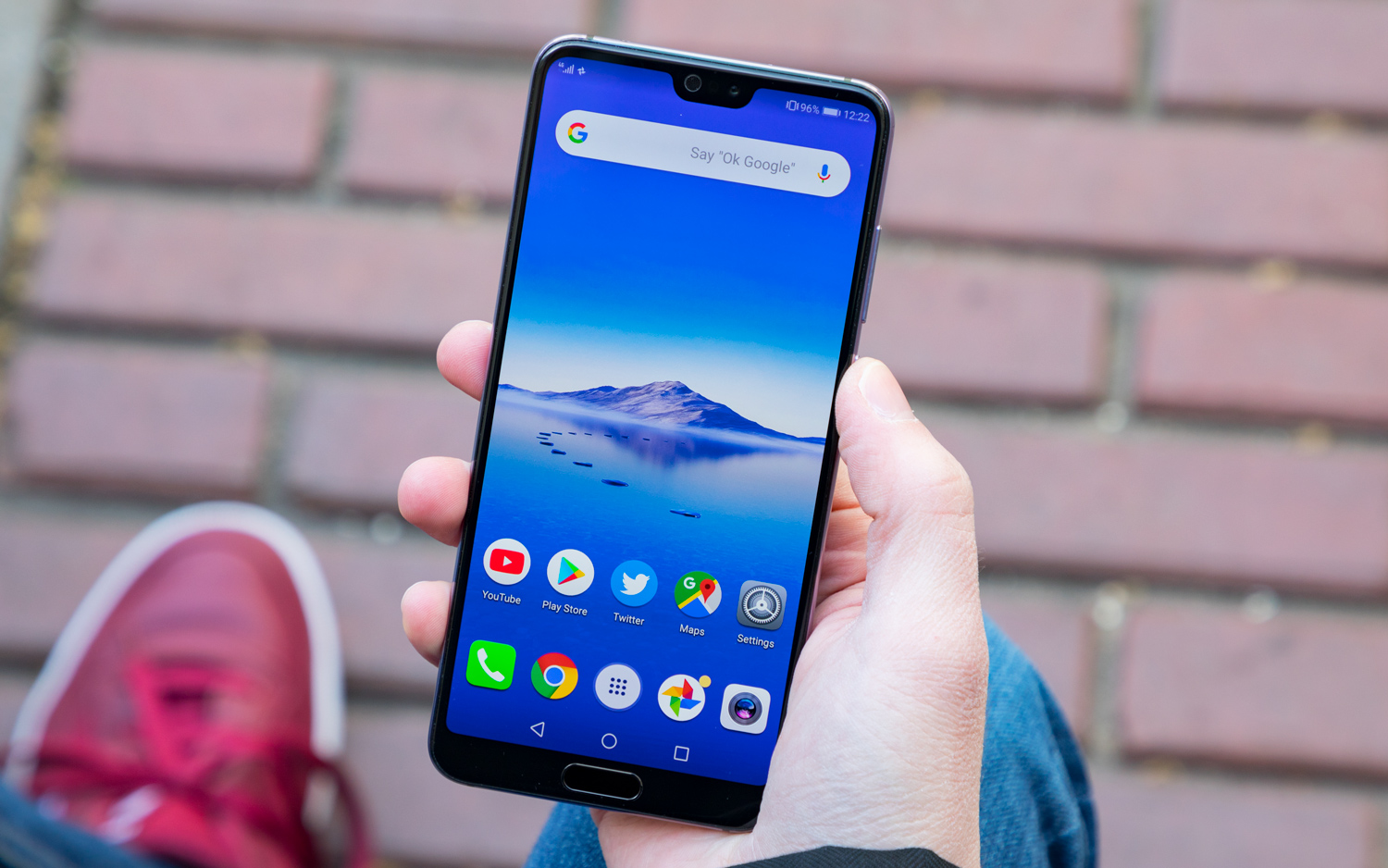
Aside from updates, the phones from Huawei and Samsung implement very different takes on Android. The P20 Pro features a graphical interface Huawei calls EMUI, while the Galaxy S9+ uses Samsung Experience. Stylistically, both of these are departures from stock software, with a number of exclusive features.
The biggest one on the Galaxy S9+ is Bixby — Samsung's virtual assistant — which has picked up a few new tricks in the company's newest handsets, like translation through the camera lens. There's also Edge panel, which allows you to stash shortcuts and contacts in an easily accessible window that is always a swipe away from any screen.
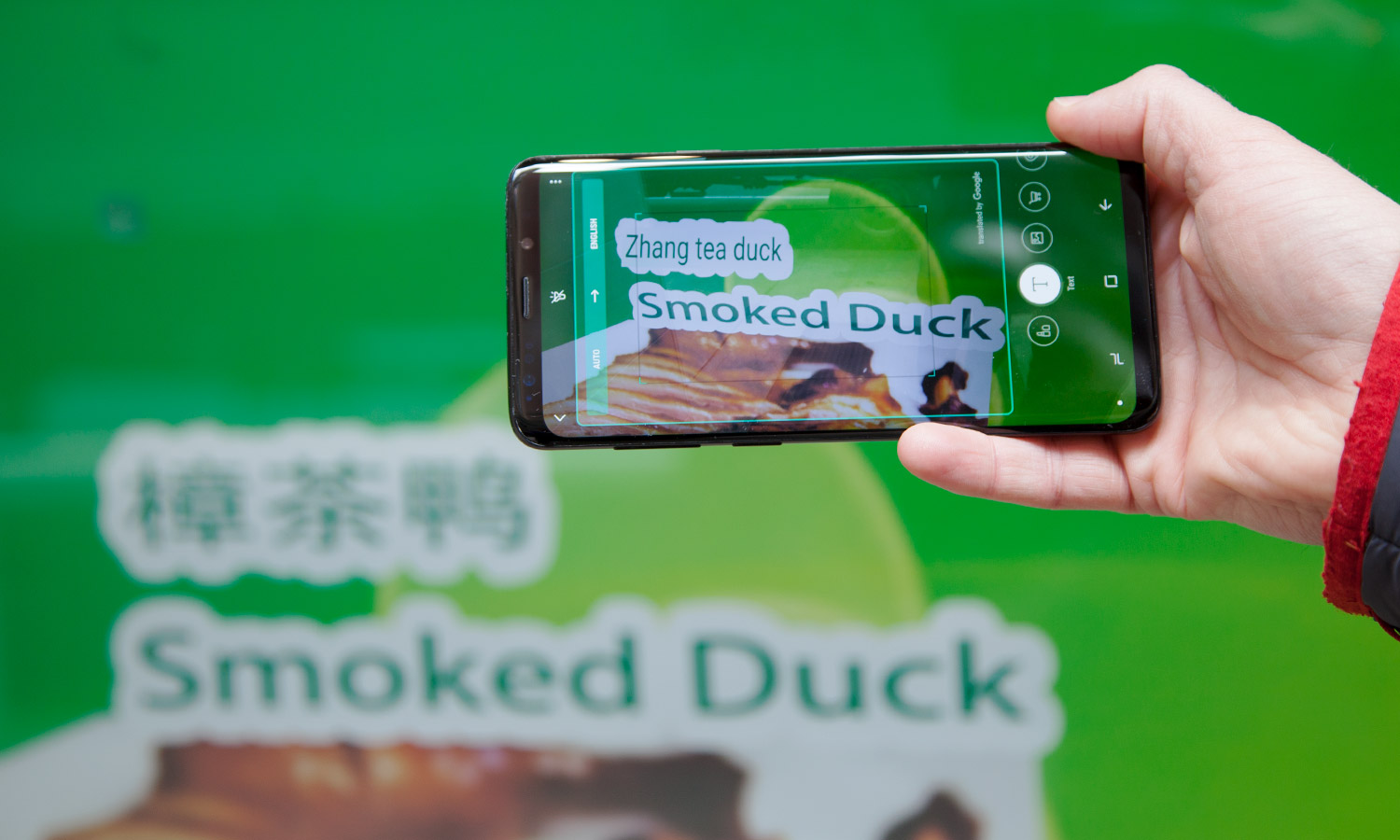
The P20 Pro doesn't have either of those, but it does allow for gestures you can assign to specific tasks. App Pair is another special feature that allows you to duplicate certain programs, which is useful if you frequently switch between different accounts on the same social media platform. And the Neural Processing Unit inside Huawei's chipset helps the P20 Pro's cameras identify objects, thus producing better photos.
Fortunately, both the Galaxy S9+ and P20 Pro can be connected to an external monitor for a makeshift desktop experience, though the P20 Pro only calls for a simple USB Type-C-to-HDMI cable. Samsung users, on the other hand, will be forced to shell out $99 for one of the company's DeX accessories — though it is somewhat more fully featured.
The P20 Pro rises to victory in this round, thanks to more up-to-date software and a boatload of special features most competitors — including Samsung — don't replicate.
Winner: Huawei P20 Pro
Price and Availability
Here's where things get dicey for those interested in Huawei's latest marvel. The P20 Pro is not sold in the U.S., which means you'll have to import an international model to get one, and you'll only be able to use it on GSM carriers, like AT&T and T-Mobile. Even then, the phone may not work as advertised on those carriers' LTE bands. (In our testing, the P20 Pro performed well on T-Mobile's LTE network around New York City, but users in rural areas may have a different experience.)
In Europe, the P20 Pro goes for 899 euros, which translates to about $1,100. That's $250 more expensive than the Galaxy S9+, which starts at $839 without factoring in the various kinds of deals that are always popping up for Samsung's flagship. Moreover, the Galaxy S9+ is available both unlocked and through carriers, and you won't have to worry about occasional subpar reception — a primary concern of international phones used within the U.S..
Winner: Samsung Galaxy S9+
Overall Winner: Samsung Galaxy S9+
As exciting as the P20 Pro's low-light camera capabilities are, Huawei's phone is just not as well-rounded a handset as the Galaxy S9+. That would be true, regardless of whether Huawei's device were sold in the U.S. or not, but the fact that it isn't makes the decision between the two phones a very easy one.
| Samsung Galaxy S9+ | Huawei P20 Pro | |
| Design (10) | 9 | 8 |
| Display (15) | 15 | 12 |
| Cameras (20) | 16 | 18 |
| Performance (10) | 9 | 7 |
| Software and Special Features (10) | 7 | 8 |
| Battery and Charging (20) | 15 | 19 |
| Value and Availability (15) | 13 | 5 |
| Overall (100) | 84 | 77 |
Buying the Galaxy S9+ will save you hundreds, not to mention all the grief that comes with importing a phone. Samsung's phone is considerably more powerful, with a better design, too. And although it can't match the 14-plus hours of battery life the P20 Pro offers, Samsung's handset lasts long enough for most people, and it even lets you charge wirelessly.
There's a reason the Galaxy S series is the go-to Android of choice for many people, and the S9+ is about as complete as they come.
Credit: Shaun Lucas/Tom's Guide
Adam Ismail is a staff writer at Jalopnik and previously worked on Tom's Guide covering smartphones, car tech and gaming. His love for all things mobile began with the original Motorola Droid; since then he’s owned a variety of Android and iOS-powered handsets, refusing to stay loyal to one platform. His work has also appeared on Digital Trends and GTPlanet. When he’s not fiddling with the latest devices, he’s at an indie pop show, recording a podcast or playing Sega Dreamcast.
-
canuck1962 An American reviewing a phone NOT allowed in the USA is the most asinine thing I will read today. The Huawei is a TOP SELLER in Canada, where it IS allowed.Reply -
tallman9 Not fair price comparison.Reply
You can get P20 Pro from China as well for as cheap as 736 euro.
And don't forget the S9+ price in europe is 950 euro. -
takeitorleaveit Reply20907355 said:An American reviewing a phone NOT allowed in the USA is the most asinine thing I will read today. The Huawei is a TOP SELLER in Canada, where it IS allowed.
Hello fellow Canadian resident. I just want to point out that the market for huawei's, even the flagship models, is very limited in Canada and they are much harder to come across even if they are sold more readily here. And there is no need to get so aggressive, this was a fair comparison and nobody reading this would could take away that the p20 pro was a bad phone by ANY means.
Source: bell mobility employee
-
Kevin-M I say neither, unless consumers start educating themselves on the cost of these devices they will continue to be the victim of greed! These phones have a markup that would make the pharmaceutical industry proud and yet we cant seem to get enough of them and continue to relish being screwed!Reply -
Curt Smith I'd like reviews to include the mfg tweek of Android on the phone. I was used to samsung, and had no idea how much useablity samsung added to the phone. My wife bought a google Pixel XL (??) newer,,, IE naked android. OMG naked android is (to me) useless crap to a business user. A bug where alerts where half loudness, no badges (those numbers saying how many messages on the message app icon). What uselessness!!!! No badges?Reply
Does this phone come with android that has LOUD alert sounds? Badge numbers on the apps showing number of messages etc etc?
I really need calendar AND SMS/text alert sounds that are loud that repeat indefinitely until I acknowledge. IE a "business" phone.. Any feed back/review comments re business use?
